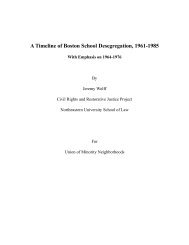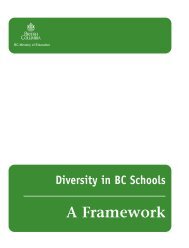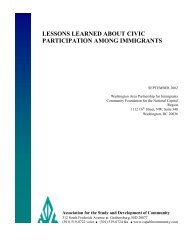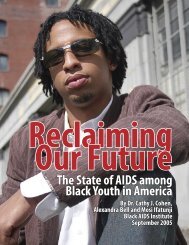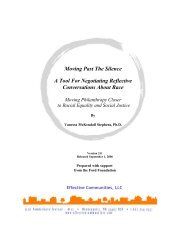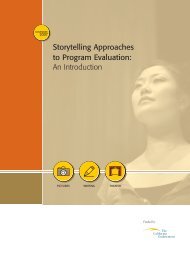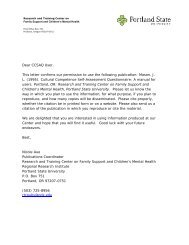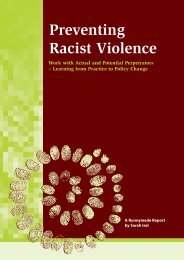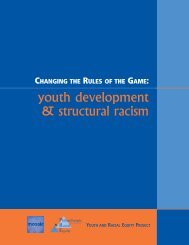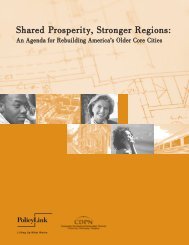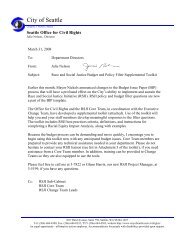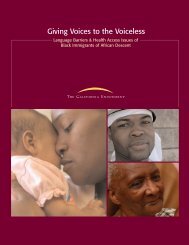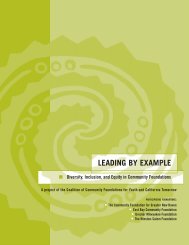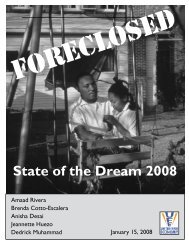ForewordAcross North America, recognition is grow<strong>in</strong>g thatcurrent public decisions guid<strong>in</strong>g l<strong>and</strong> use <strong>and</strong>development are putt<strong>in</strong>g at risk people, theenvironment, <strong>and</strong> the economy. Manifestations <strong>of</strong> thesedecisions <strong>in</strong>clude <strong>in</strong>creas<strong>in</strong>g social <strong>and</strong> economic<strong>in</strong>equity, accelerat<strong>in</strong>g concentrations <strong>of</strong> poverty,weaken<strong>in</strong>g <strong>of</strong> public schools, grow<strong>in</strong>g traffic congestion,worsen<strong>in</strong>g air quality, <strong>and</strong> jobs locat<strong>in</strong>g farther <strong>and</strong>farther away from homes <strong>and</strong> apartments that familiescan afford. <strong>Regional</strong> growth <strong>and</strong> development patternspr<strong>of</strong>oundly impact the life circumstances <strong>of</strong> low-<strong>in</strong>comecommunities <strong>and</strong> people <strong>of</strong> color. Too many people are<strong>of</strong>ten isolated <strong>in</strong> neighborhoods without liv<strong>in</strong>g wagejobs or without the public transit needed to accessemployment <strong>in</strong> other parts <strong>of</strong> the region. Too manychildren struggle <strong>in</strong> poor quality, deteriorat<strong>in</strong>g schools.Too many live <strong>in</strong> communities plagued with poor air<strong>and</strong> water quality <strong>and</strong> toxic sites. Too manyneighborhoods lack important services <strong>and</strong> amenitieslike full-service grocery stores, banks, safe parks, <strong>and</strong><strong>in</strong>vit<strong>in</strong>g public spaces.As a result <strong>of</strong> the grow<strong>in</strong>g awareness <strong>of</strong> <strong>and</strong> concernabout these problems, an <strong>in</strong>creas<strong>in</strong>g number <strong>of</strong> people<strong>and</strong> organizations have emerged to call for betterdecisionmak<strong>in</strong>g about growth <strong>and</strong> development.While these emerg<strong>in</strong>g movements use various names—smart growth, regional equity, social justice, NewUrbanism—together they have the potential topr<strong>of</strong>oundly <strong>in</strong>fluence the future shape <strong>of</strong> communities.But this will only occur if they dem<strong>and</strong> thatdecisionmakers look at the big picture, make choicesthat improve the entire community, consider all theoptions, make fairness a priority, <strong>and</strong> guaranteemean<strong>in</strong>gful citizen participation <strong>in</strong> public decisions.We believe strongly that these movements for a betterenvironment, stronger economy, <strong>and</strong> social justice canbe far more effective <strong>in</strong> reach<strong>in</strong>g their potential byjo<strong>in</strong><strong>in</strong>g together, rather than focus<strong>in</strong>g on these separateissues <strong>in</strong> isolation from one another. A grow<strong>in</strong>gnumber <strong>of</strong> experiments, projects, <strong>and</strong> <strong>in</strong>itiatives nowexist on the ground across North America that showhow funders <strong>and</strong> grantees are work<strong>in</strong>g acrossdiscipl<strong>in</strong>es to achieve significant <strong>and</strong> last<strong>in</strong>g progress—progress that will ensure that all people <strong>and</strong> familiescan participate <strong>in</strong> <strong>and</strong> benefit from economic growth<strong>and</strong> activity throughout regions. We are pleased to<strong>of</strong>fer to you this report to showcase some <strong>of</strong> theseexcit<strong>in</strong>g efforts <strong>and</strong> help you learn from them.Philanthropy has a critical role to play <strong>in</strong> lead<strong>in</strong>gefforts to demonstrate how we can advance aregional <strong>and</strong> neighborhood equity framework. TheFunders’ Network seeks to help funders to fulfill thisrole by help<strong>in</strong>g them learn from <strong>and</strong> advance bestpractices; lift up promis<strong>in</strong>g examples <strong>and</strong> projects;<strong>and</strong> work together to <strong>in</strong>crease their leverage <strong>and</strong>impact. This report by the <strong>Regional</strong> <strong>and</strong>Neighborhood Equity Project (RNEP) <strong>of</strong> theFunders’ Network is <strong>in</strong>tended to contribute to theseoutcomes. The pr<strong>of</strong>iles highlighted <strong>in</strong> this reportrepresent years <strong>of</strong> work by the members <strong>of</strong> RNEP,the funders that have come before them, <strong>and</strong> theirhigh perform<strong>in</strong>g grantees <strong>and</strong> partners.The release <strong>of</strong> this report co<strong>in</strong>cides with an importantevent—Advanc<strong>in</strong>g <strong>Regional</strong> Equity: The SecondNational Summit on Equitable Development,Social Justice, <strong>and</strong> Smart Growth—on May 23-25,2005, <strong>in</strong> Philadelphia. S<strong>in</strong>ce its found<strong>in</strong>g, the Funders’Network has worked to develop a deeperunderst<strong>and</strong><strong>in</strong>g <strong>of</strong> smart growth <strong>and</strong> its potential forpromot<strong>in</strong>g regional <strong>and</strong> neighborhood equity. Muchprogress has occurred but there is much more to bedone. The 2 nd National Summit provides a venue tocelebrate successes thus far <strong>and</strong> to share, learn, <strong>and</strong> setstrategic priorities for advanc<strong>in</strong>g better decisionmak<strong>in</strong>gso that future growth <strong>and</strong> development will make ourregions <strong>and</strong> communities places <strong>of</strong> opportunity foreveryone. We hope this report <strong>and</strong> the 2 nd NationalSummit help build greater underst<strong>and</strong><strong>in</strong>g <strong>in</strong> the field<strong>and</strong> move us forward to the next level <strong>of</strong> action.Carl AnthonyChair, <strong>Regional</strong> <strong>and</strong>Neighborhood Equity ProjectAct<strong>in</strong>g Director, Community <strong>and</strong>Resource Development Unit,Ford FoundationL Benjam<strong>in</strong> StarrettExecutive DirectorFunders’ Network for SmartGrowth <strong>and</strong> Livable Communities1 Funders’ Network for Smart Growth <strong>and</strong> Livable Communities
PART I:IntroductionThe Purpose <strong>of</strong> this ReportThe Funders’ Network for Smart Growth <strong>and</strong>Livable Communities commissioned this report tohelp document the progress be<strong>in</strong>g made by funders<strong>and</strong> their partner organizations to advance regional<strong>and</strong> neighborhood equity on the ground <strong>in</strong> regions<strong>and</strong> communities across North America. The storiesshared here highlight not only specific projects <strong>and</strong>organizations, but also share lessons learned bygrantmakers who have been <strong>in</strong>volved <strong>in</strong> <strong>and</strong> arecommitted to support<strong>in</strong>g them.Throughout North America, cities have sufferedfrom the migration <strong>of</strong> jobs, population, <strong>in</strong>vestmentcapital, <strong>and</strong> opportunity away from urban centers<strong>and</strong> <strong>in</strong>to the fr<strong>in</strong>ges <strong>of</strong> metropolitan areas. Thispattern, commonly referred to as sprawl, has beenthe dom<strong>in</strong>ant shape <strong>of</strong> growth <strong>and</strong> development forover 50 years. It is the result <strong>of</strong> both public decisionsabout l<strong>and</strong> use <strong>and</strong> the process by which thosedecisions are made.Low-<strong>in</strong>come communities <strong>and</strong> people <strong>of</strong> color have beenforced to pay a terrible price by these public decisions.Too many neighborhoods are isolated, cut-<strong>of</strong>f from theeconomic opportunities, services, <strong>and</strong> social networkscritical for full participation <strong>in</strong> society. The residents <strong>of</strong>these communities live with high crime rates, crumbl<strong>in</strong>g<strong>in</strong>frastructure, poor services, <strong>and</strong> <strong>in</strong>adequate hous<strong>in</strong>g.Re<strong>in</strong>vestment, where it does occur, <strong>of</strong>ten fails to addressthe needs <strong>and</strong> aspirations <strong>of</strong> the residents <strong>of</strong> thesecommunities, which can lead to displacement <strong>and</strong>further isolation. Gentrification <strong>and</strong> dis<strong>in</strong>vestment donot necessarily operate <strong>in</strong> isolation. In many <strong>in</strong>stancesone community is struggl<strong>in</strong>g with the costs <strong>and</strong> benefits<strong>of</strong> gentrification while a neighbor<strong>in</strong>g community <strong>in</strong> thesame region rema<strong>in</strong>s severely dis<strong>in</strong>vested.Until relatively recently, the <strong>in</strong>terplay betweenregional development patterns <strong>and</strong> <strong>in</strong>equality/<strong>in</strong>equityhas not been widely addressed by social justiceadvocates. As this report documents, this is beg<strong>in</strong>n<strong>in</strong>gto change. Many foundations are develop<strong>in</strong>g <strong>and</strong>encourag<strong>in</strong>g <strong>in</strong>novative approaches to l<strong>in</strong>k advocacyfor social justice to policy change focused on l<strong>and</strong> use<strong>and</strong> regional plann<strong>in</strong>g. Recogniz<strong>in</strong>g that l<strong>and</strong> usedecisions impact a broad range <strong>of</strong> issues that funderscare about (such as poverty alleviation, economicopportunity, the state <strong>of</strong> children <strong>and</strong> families, <strong>and</strong>more), s<strong>in</strong>ce its <strong>in</strong>ception, the Funders’ Network forSmart Growth <strong>and</strong> Livable Communities haspartnered with organizations such as PolicyL<strong>in</strong>k toadvance the objectives<strong>of</strong> opportunity,justice, <strong>and</strong> equity byencourag<strong>in</strong>g betterdecisions aboutgrowth <strong>and</strong>development.The <strong>in</strong>tendedaudience for thisreport <strong>in</strong>cludesfunders, <strong>in</strong>dividuals,<strong>and</strong> organizations advocat<strong>in</strong>g for better plann<strong>in</strong>g <strong>and</strong>decisionmak<strong>in</strong>g to improve communities <strong>and</strong>regions. Several goals exist for this report. At onelevel, its purpose is to lift up the pr<strong>of</strong>iled projects asnational examples <strong>of</strong> foundation leadership <strong>in</strong> orderto encourage other funders to engage <strong>in</strong> this work.Second, its purpose is to demonstrate to keystakeholders that extend beyond philanthropy—public <strong>and</strong> private sector leaders, practitioners, <strong>and</strong>advocates—that cross-sectoral collaborations cancreate susta<strong>in</strong>ed progress. F<strong>in</strong>ally, this report isdesigned to <strong>in</strong>spire, catalyze, <strong>and</strong> strengthenphilanthropic leadership <strong>and</strong> exp<strong>and</strong> funders’ abilitiesto support organizations work<strong>in</strong>g to build moreequitable <strong>and</strong> livable communities.The Movement for Smarter GrowthMany foundations aredevelop<strong>in</strong>g <strong>and</strong> encourag<strong>in</strong>g<strong>in</strong>novative approaches to l<strong>in</strong>kadvocacy for social justiceto policy change focused onl<strong>and</strong> use <strong>and</strong> regionalplann<strong>in</strong>g.Place-based strategies for improv<strong>in</strong>g communities <strong>and</strong>regions have coalesced <strong>in</strong>to a movement based on a set<strong>of</strong> pr<strong>in</strong>ciples known as smart growth. The AmericanPlann<strong>in</strong>g Association (APA) def<strong>in</strong>es smart growth asus<strong>in</strong>g comprehensive plann<strong>in</strong>g to guide, design,develop, revitalize, <strong>and</strong> build communities that:• Value long-range, regional considerations <strong>of</strong>susta<strong>in</strong>ability over short-term, <strong>in</strong>cremental,geographically isolated actions;• Preserve <strong>and</strong> enhance valuable natural <strong>and</strong>cultural resources;• Equitably distribute the costs <strong>and</strong> benefits <strong>of</strong>development;Part I: Introduction2
- Page 1 and 2: Stories of Philanthropic Leadership
- Page 3 and 4: Signs of Promise:Stories of Philant
- Page 5 and 6: Funders’ Network for Smart Growth
- Page 7: (II. B.)(II. C.)Turning Neighborhoo
- Page 11 and 12: social justice issues as they relat
- Page 13 and 14: PART II:Perspectives on Advancing R
- Page 15 and 16: peer work, we can reestablish a sig
- Page 17 and 18: Annie E. Casey FoundationBaltimore,
- Page 19 and 20: neighborhoods into healthy ones—g
- Page 21 and 22: Charles and Helen Schwab Foundation
- Page 23 and 24: Section 1:Promoting Equitable Publi
- Page 25 and 26: I. A. BUILDING POWER AND GIVINGVOIC
- Page 27 and 28: policy advocates. In 2002, Milwauke
- Page 29 and 30: in Los Angeles, Ford’s Anthony no
- Page 31 and 32: I. B. PROMOTING COALITIONSTO ADVANC
- Page 33 and 34: Yet the interpersonal dynamics of c
- Page 35 and 36: guidelines. “Many of the member o
- Page 37 and 38: Funder InterestThe EPA supported th
- Page 39 and 40: I. D. DEMONSTRATING THESTRUGGLE FOR
- Page 41 and 42: Richmond, Calif.The second regional
- Page 43 and 44: through policy reform at the local
- Page 45 and 46: I. E. BUILDING COALITIONTHROUGH KNO
- Page 47 and 48: organizing project, the Connecticut
- Page 49 and 50: and businesses are quantified in a
- Page 51 and 52: I. G. REVITALIZING WHILEASSURING DI
- Page 53 and 54: In the late 1990s, the city of Albu
- Page 55 and 56: I. H. A TRAVEZ DE LA FRONTERA:LAND
- Page 57 and 58: The International Community Foundat
- Page 59 and 60:
I. I. MOBILIZING ACTION FORREGIONAL
- Page 61 and 62:
To meet all of these objectives, th
- Page 63 and 64:
efforts. And with each public plann
- Page 65 and 66:
pattern of disproportionate transpo
- Page 67 and 68:
Clinica de la Raza identify this cr
- Page 69 and 70:
Contact PeopleCarl AnthonyActing Di
- Page 71 and 72:
Section 2:Making All Neighborhoods
- Page 73 and 74:
II. A. REACHING BEYONDHOUSING TO IM
- Page 75 and 76:
A local resident receives the keys
- Page 77 and 78:
East Baltimore community and the Jo
- Page 79 and 80:
example, adjacent to the EBDI area,
- Page 81 and 82:
II. C. YIELDING REGIONALBENEFITS TH
- Page 83 and 84:
is using transit-oriented developme
- Page 85 and 86:
financing and innovative, forward-t
- Page 87 and 88:
The Row House Community Development
- Page 89 and 90:
II. E. COUNTERING THE PERFECTSTORM:
- Page 91 and 92:
funded community programs, includin
- Page 93 and 94:
housing developments and commercial
- Page 95 and 96:
owned enterprises, totaling $8.5 mi
- Page 97 and 98:
LOAN GUARANTEESSection 3:Connecting
- Page 99 and 100:
III. A. MAKING HOUSING ANOPPORTUNIT
- Page 101 and 102:
A new report from the National Hous
- Page 103 and 104:
The Straphangers Campaign was found
- Page 105 and 106:
Funder InterestThe Straphangers Cam
- Page 107 and 108:
or increase poverty. Whether direct
- Page 109 and 110:
The Regional Plan Association then
- Page 111 and 112:
multi-stakeholder effort composed o
- Page 113 and 114:
director with LISC. No one set of s
- Page 115 and 116:
12 western Louisville neighborhoods
- Page 117 and 118:
III. E. UNITING THREE STATESFOR ONE
- Page 119 and 120:
increased their personal wealth by
- Page 121 and 122:
summary evaluation of MSDI found th
- Page 123 and 124:
method alone was strong enough to m
- Page 125 and 126:
consistent body of work. The Counci
- Page 127 and 128:
3) Issues Need to be ConnectedThe f
- Page 129 and 130:
PART V:Glossary of TermsThe terms d
- Page 131 and 132:
Regional and neighborhood equity. A
- Page 133 and 134:
Tijuana River Reserve, California:h
- Page 135 and 136:
Sargent Shriver National Center on
- Page 137:
1500 San Remo Avenue • Suite 249



